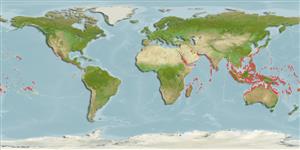>
Ovalentaria/misc (Various families in series Ovalentaria) >
Pomacentridae (Damselfishes) > Chrominae
Etymology: Chromis: Greek, chromis = a fish, perhaps a perch (Ref. 45335).
More on author: Cuvier.
Environment: milieu / climate zone / depth range / distribution range
Ecología
marino asociado a arrecife; no migratorio; rango de profundidad 1 - 20 m (Ref. 86942). Subtropical; 35°N - 35°S
Indo-Pacific: East coast of Africa to the Line Islands and Tuamotu Archipelago; north to Ryukyu Islands, south to the Great Barrier Reef and New Caledonia.
Length at first maturity / Tamaño / Peso / Age
Maturity: Lm 5.8 range ? - ? cm
Max length : 10.0 cm TL macho / no sexado; (Ref. 90102)
Espinas dorsales (total): 12; Radios blandos dorsales (total): 9-11; Espinas anales 2; Radios blandos anales: 9 - 11.
Adults are found in large aggregations above thickets of branching Acropora corals in sheltered areas such as subtidal reef flats and lagoons. Juveniles closely tied to individual coral heads (Ref. 9710). Phytoplankton feeders. Breeding is done on sand and rubble. Males prepare nest for spawning which is shared with several females. Large number of eggs spawned hatching in 2-3 days. Males guard the nest ventilating fertilized egg with their caudal fins and feeding on those which do not hatch. Oviparous, distinct pairing during breeding (Ref. 205). Eggs are demersal and adhere to the substrate (Ref. 205). Diurnal species (Ref. 54980; 113699).
Life cycle and mating behavior
Madurez | Reproducción | Puesta | Huevos | Fecundidad | Larva
Oviparous, distinct pairing during breeding (Ref. 205). Eggs are demersal and adhere to the substrate (Ref. 205). Males guard and aerate the eggs (Ref. 205).
Allen, G.R., 1991. Damselfishes of the world. Mergus Publishers, Melle, Germany. 271 p. (Ref. 7247)
IUCN Red List Status (Ref. 130435)
Threat to humans
Harmless
Human uses
Acuario: Comercial
Más información
ReferenciasAcuiculturaPerfil de acuiculturaRazasGenéticaElectrophoresesheritabilidadEnfermedadesProcesamientoNutrientsMass conversion
Herramientas
Special reports
Download XML
Fuentes de Internet
Estimates based on models
Preferred temperature (Ref.
123201): 24.6 - 29.3, mean 28.3 °C (based on 3292 cells).
Phylogenetic diversity index (Ref.
82804): PD
50 = 0.5000 [Uniqueness, from 0.5 = low to 2.0 = high].
Bayesian length-weight: a=0.02089 (0.01266 - 0.03448), b=2.90 (2.76 - 3.04), in cm total length, based on LWR estimates for this species & Genus-body shape (Ref.
93245).
Nivel trófico (Ref.
69278): 2.9 ±0.1 se; based on diet studies.
Resiliencia (Ref.
120179): Alto, población duplicada en un tiempo mínimo inferior a 15 meses (Preliminary K or Fecundity.).
Fishing Vulnerability (Ref.
59153): Low vulnerability (10 of 100).
Nutrients (Ref.
124155): Calcium = 83 [35, 149] mg/100g; Iron = 0.902 [0.484, 1.680] mg/100g; Protein = 18.8 [17.5, 20.1] %; Omega3 = 0.171 [0.087, 0.335] g/100g; Selenium = 10.2 [4.2, 23.0] μg/100g; VitaminA = 86.7 [20.3, 355.3] μg/100g; Zinc = 1.11 [0.66, 1.78] mg/100g (wet weight);
